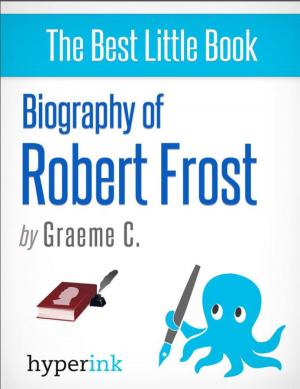Quicklet On Charles Darwin's The Origin of Species
Fiction & Literature, Literary Theory & Criticism| Author: | Nicole Silvester | ISBN: | 9781484006863 |
| Publisher: | Hyperink | Publication: | February 8, 2012 |
| Imprint: | Hyperink | Language: | English |
| Author: | Nicole Silvester |
| ISBN: | 9781484006863 |
| Publisher: | Hyperink |
| Publication: | February 8, 2012 |
| Imprint: | Hyperink |
| Language: | English |
ABOUT THE BOOK
The Origin of Species by Charles Darwin is arguably one of the most important works of scientific writing ever to be published. Science today recognizes that the principles of natural selection Darwin described are the primary driving forces behind the evolution of new species, and evolution itself underpins all of the biological sciences, including medicine.
For a natural historian, whether a professional scientist, or an avid amateur like me, Darwin’s work is an illustration of how a single dedicated individual can look at the mind-boggling variety of life on our planet and make sense of it. Though few people have read the book, nearly everyone has read about it. Those who do venture to crack the covers of the Origin (as it’s commonly known) discover a surprisingly readable account, though one dense with details and examples.
It is the sort of book that can take some effort to get all the way through, but which leaves the reader feeling it was a worthwhile effort. For me, it underlined the beauty and richness of life on Earth, and gave me many new avenues down which to let my curiosity wander. It is also a testament to the kind of meticulous research, combined with brilliant thinking, upon which the best science depends.
MEET THE AUTHOR
Nicole has been writing since she could make letters with a pencil, and has been making a living at it for more than ten years. She has gone back to school too many times, studying archaeology, folklore, writing and visual art. She writes fiction under several pen names, and also does printmaking, book arts, and photography. She's an avid amateur natural historian with a particular fascination for things that fly, whether it's birds, bats or insects. And if it's possible to be both a luddite, with a love for the low-tech, and a technophile, with a fascination for everything new and shiny, Nicole is both. She reads too many books, plays too many video games, and watches too much anime.
EXCERPT FROM THE BOOK
It is difficult to overstate the importance of The Origin of Species. It has been both loved and reviled, but Darwin’s theory has stood up to repeated challenges until it has become what scientists call a “robust theory”—for a layperson, there is little difference between that and a “fact.” A robust theory is one that has “been tested and confirmed again and again.”
It took Charles Darwin many years to write his masterwork, and he only really considered publishing it when it came to his attention in 1855 that a younger scientist—Alfred Russel Wallace—was working on a similar theory. Without that impetus, the book would likely have taken many more years. Wallace’s work, which he sent to Darwin in 1858 in a 20-page paper outlining an evolutionary theory similar to Darwin’s, finally provided the impetus for Darwin to set down his ideas in a form others could read. In the end, the two men claimed joint discovery of the mechanisms of evolution, though it’s Darwin whose name we remember, and Darwin’s thorough and meticulous work that gave the theory its strongest support.
Darwin had actually worked out his basic theory of natural selection by 1838, but he was such a perfectionist that he didn’t publish it until nearly 20 years later. With each new edition of the Origin, Darwin added additional examples and evidence, and answered many challenges from his scientific opponents. And though today the Origin is considered to be a work only read by scientists, it was actually written for the general public, and was widely read at the time.
Buy a copy to keep reading!
ABOUT THE BOOK
The Origin of Species by Charles Darwin is arguably one of the most important works of scientific writing ever to be published. Science today recognizes that the principles of natural selection Darwin described are the primary driving forces behind the evolution of new species, and evolution itself underpins all of the biological sciences, including medicine.
For a natural historian, whether a professional scientist, or an avid amateur like me, Darwin’s work is an illustration of how a single dedicated individual can look at the mind-boggling variety of life on our planet and make sense of it. Though few people have read the book, nearly everyone has read about it. Those who do venture to crack the covers of the Origin (as it’s commonly known) discover a surprisingly readable account, though one dense with details and examples.
It is the sort of book that can take some effort to get all the way through, but which leaves the reader feeling it was a worthwhile effort. For me, it underlined the beauty and richness of life on Earth, and gave me many new avenues down which to let my curiosity wander. It is also a testament to the kind of meticulous research, combined with brilliant thinking, upon which the best science depends.
MEET THE AUTHOR
Nicole has been writing since she could make letters with a pencil, and has been making a living at it for more than ten years. She has gone back to school too many times, studying archaeology, folklore, writing and visual art. She writes fiction under several pen names, and also does printmaking, book arts, and photography. She's an avid amateur natural historian with a particular fascination for things that fly, whether it's birds, bats or insects. And if it's possible to be both a luddite, with a love for the low-tech, and a technophile, with a fascination for everything new and shiny, Nicole is both. She reads too many books, plays too many video games, and watches too much anime.
EXCERPT FROM THE BOOK
It is difficult to overstate the importance of The Origin of Species. It has been both loved and reviled, but Darwin’s theory has stood up to repeated challenges until it has become what scientists call a “robust theory”—for a layperson, there is little difference between that and a “fact.” A robust theory is one that has “been tested and confirmed again and again.”
It took Charles Darwin many years to write his masterwork, and he only really considered publishing it when it came to his attention in 1855 that a younger scientist—Alfred Russel Wallace—was working on a similar theory. Without that impetus, the book would likely have taken many more years. Wallace’s work, which he sent to Darwin in 1858 in a 20-page paper outlining an evolutionary theory similar to Darwin’s, finally provided the impetus for Darwin to set down his ideas in a form others could read. In the end, the two men claimed joint discovery of the mechanisms of evolution, though it’s Darwin whose name we remember, and Darwin’s thorough and meticulous work that gave the theory its strongest support.
Darwin had actually worked out his basic theory of natural selection by 1838, but he was such a perfectionist that he didn’t publish it until nearly 20 years later. With each new edition of the Origin, Darwin added additional examples and evidence, and answered many challenges from his scientific opponents. And though today the Origin is considered to be a work only read by scientists, it was actually written for the general public, and was widely read at the time.
Buy a copy to keep reading!















